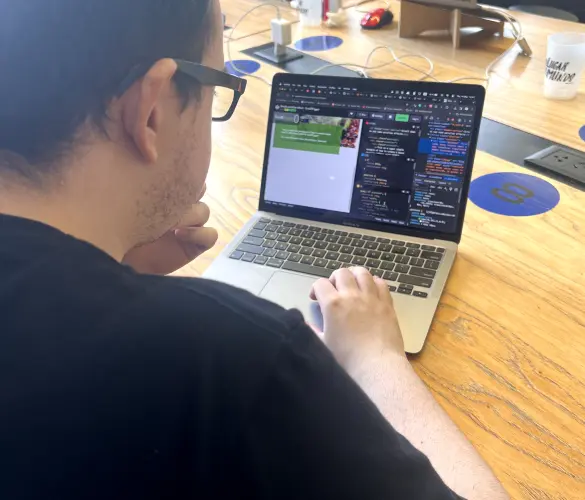- Blogs
- Behind the Canvas
- How to Perform a Thorough Audit for WordPress Content Migration Projects
Behind the Canvas / 4 min read
How to Perform a Thorough Audit for WordPress Content Migration Projects

Content migration is a critical and sometimes tricky phase in WordPress redesign projects. If teams don’t approach it strategically from the beginning, it can easily become a long, tedious and costly process with lots of unexpected manual tasks.
In this article, we’ll explore the challenges we faced during a recent content migration project for Girls Write Now (GWN), a nonprofit organization that promotes writing and leadership in women, and the lessons we learned from it.
We’ll discuss the challenges we faced and how we’ve adjusted our approach to resolve them in future projects.
The Importance of Content Planning and Auditing in WordPress Migrations
One of the keys to a successful migration is early planning, which includes a thorough audit of the client’s existing content.
This audit allows developers and QA analysts to identify inconsistencies, content duplicates, and non-standard formats that could complicate the migration. It also ensures that we don’t migrate any content that is irrelevant to the new site.
In our project with GWN, we performed an initial audit, but as the project progressed, we realized that we had missed several important details.
For example, content uploaded to the GWN site over the years didn’t always follow uniform criteria, resulting in many posts with disparate formats that complicate migration.
Missing these inconsistencies in the early stages of the project led to the need for manual adjustments in advanced phases, impacting both timelines and budgets.
The Most Common Challenges Teams Face During WordPress Content Migration
Our experience during the GWN content migration highlights some of the most common challenges teams face in these types of projects. Some of the issues were:
- Inconsistent formats. Content had been uploaded at different times without following a standard, making it difficult to identify what was relevant or duplicated.
- Underestimating the complexity of the project. The team did not anticipate the amount of manual work that would be necessary, leading to an overload of tasks in the final phases.
- Incomplete audit processes. An incomplete audit in the early stages of the project unnecessarily lengthens the migration time and increases the number of unforeseen adjustments.
Not anticipating these challenges can easily lead to a longer migration time due to unforeseen manual tasks, budget overruns, and delayed deliveries.
Best Practices for WordPress Content Migration
Based on what we learned with the GWN project, here are some best practices to ensure an efficient content migration:
- Perform a comprehensive audit from the start. Conduct a detailed analysis of all existing content, identifying what to migrate, update, and discard.
- Create a content inventory. Create a complete inventory of all pages, articles, and media assets.
- Standardize content formats. Ensure that all content, including titles, metadata, and page structure, follows a consistent format.
- Perform pilot tests. Conduct an initial small-scale migration to detect issues before migrating all content.
- Communicate constantly. Maintain clear and consistent communication with your clients, ensuring they agree on what content to migrate or discard.
- Use automation tools. Use WordPress-specific plugins and tools to automate parts of the migration process and reduce manual errors. We’ve used WP All Import to great success in multiple projects now.
Proper planning and auditing can significantly impact the efficiency and quality of your content migration project. It reduces manual work, avoids costly mistakes, and ensures the final content is consistent with the new site’s structure.
A Thorough Audit Improves Your WordPress Content Migration Projects
Our GWN project demonstrates the importance of rigorous auditing and planning when migrating content in WordPress.
An early and thorough audit not only saves time and resources but also ensures the consistency and quality of the migrated content. To avoid the issues that arose during our project with GWN, it is essential to follow the best practices described above, rely on automated tools, and maintain constant communication with the client.
A well-executed migration facilitates the delivery of a functional and well-designed site and improves client satisfaction by meeting agreed-upon timelines and budgets.
Hopefully, this information will be useful for your WordPress development team, and you can use it to improve future migration projects. If you found this post useful, read our blog and developer resources for more insights and guides!
Related Articles

How to... / 3 min read
How to... / 3 min read
How to Grant Secure Access to a Not Live WordPress Site During Development
When developing a WordPress site, you often need to collaborate with multiple developers and grant access to the website owner so they can review the progress themselves. However, granting access…
Read More
How to... / 5 min read
How to... / 5 min read
How to Add Text Borders in WordPress (2 Methods)
If you’re starting to explore WordPress’s many styling options, you may be wondering how to add text borders to your WordPress site. Depending on what you’re trying to do, adding…
Read More
How to... / 6 min read
How to... / 6 min read
How to Change the Bottom Padding Dimensions on WordPress Blocks
If you're learning to modify your WordPress site's layouts and design, you may be wondering how to change the bottom padding dimensions of some of its elements. If that's the…
Read More
How to... / 10 min read
How to... / 10 min read
How to Disable the “Similar Posts” Section in WordPress Blogs
If you’re diving deeper into customizing your site, you may be wondering how to disable the “Similar Posts” section that appears on the bottom, sidebar, or footer of your WordPress…
Read More
How to... / 8 min read
How to... / 8 min read
How to Change the Width of a Blog Post on WordPress (3 Methods)
If you're diving deep into WordPress web design, you'll eventually need to learn how to change the width of a blog on your WordPress site. It can improve readability or…
Read More